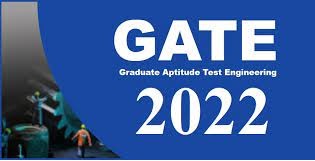Graduate Aptitude Test in Engineering (GATE) Exam 2022 : gate.iitkgp.ac.in
Organisation : Indian Institute of Technology Kharagpur
Exam Name : Graduate Aptitude Test in Engineering (GATE) Exam 2022
Announcement : Graduate Aptitude Test in Engineering (GATE) Exam Syllabus
Website : https://gate.iitkgp.ac.in/index.html
What is GATE Exam?
The Graduate Aptitude Test in Engineering (GATE) is an examination that primarily tests the comprehensive understanding of various undergraduate subjects in engineering and science for admission into the Masters Program and Recruitment by some Public Sector Companies. GATE 2022 is conducted by the Indian Institute of Technology Kharagpur and six other Indian Institutes of Technology at Mumbai, Delhi, Guwahati, Kanpur, Chennai, Roorkee & Indian Institute of Science at Bengaluru on behalf of the National Coordination Board – GATE, The Department of Higher Education, Ministry of Education (MoE), Government of India.

Syllabus For GATE Exam
The Syllabus For GATE Exam are given below,
1. Aerospace Engineering
Section1: Engineering Mathematics
Core Topics:
Linear Algebra: Vector algebra, Matrix algebra, systems of linear equations, rank of a
matrix, eigenvalues and eigenvectors.
Calculus: Functions of single variable, limits, continuity and differentiability, mean value
theorem, chain rule, partial derivatives, maxima and minima, gradient, divergence and
curl, directional derivatives. Integration, Line, surface and volume integrals. Theorems
of Stokes, Gauss and Green.
Differential Equations: First order linear and nonlinear differential equations, higher
order linear ODEs with constant coefficients. Partial differential equations and
separation of variables methods.
Special Topics: Fourier Series, Laplace Transforms, Numerical methods for linear and
nonlinear algebraic equations, Numerical integration and differentiation. Complex
analysis. Probability and statistics.
Section 2: Flight Mechanics
Core Topics:
Basics:
Atmosphere: Properties, standard atmosphere. Classification of aircraft. Airplane (fixed
wing aircraft) configuration and various parts. Pressure altitude; equivalent, calibrated,
indicated air speeds; Primary flight instruments: Altimeter, ASI, VSI, Turn-bank
indicator. Angle of attack, sideslip; Roll, pitch & yaw controls. Aerodynamic forces and
moments.
Airplane performance: Drag polar; takeoff and landing; steady climb & descent;
absolute and service ceiling; range and endurance, load factor, turning flight, V-n
diagram. Winds: head, tail & cross winds.
Static stability: Stability & control derivatives; longitudinal stick fixed & free stability;
horizontal tail position and size; directional stability, vertical tail position and size; lateral
stability. Wing dihedral, sweep & position; hinge moments, stick forces.
Special Topics: Dynamic stability: Euler angles; Equations of motion; Decoupling of
longitudinal and lateral-directional dynamics; longitudinal modes; lateral-directional modes.
Section 3: Space Dynamics
Core Topics:
Central force motion, determination of trajectory and orbital period in simple cases. Kepler’s laws;
escape velocity.
No Special Topics:
Section 4: Aerodynamics
Core Topics:
Basic Fluid Mechanics: Conservation laws: Mass, momentum and energy (Integral and differential
form); Dimensional analysis and dynamic similarity;
Potential flow theory: sources, sinks, doublets, line vortex and their superposition. Elementary ideas
of viscous flows including boundary layers.
Airfoils and wings: Airfoil nomenclature; Aerodynamic coefficients: lift, drag and moment; Kutta-
Joukoswki theorem; Thin airfoil theory, Kutta condition, starting vortex; Finite wing theory: Induced
drag, Prandtl lifting line theory; Critical and drag divergence Mach number.
Compressible Flows: Basic concepts of compressibility, One-dimensional compressible flows,
Isentropic flows, Fanno flow, Rayleigh flow; Normal and oblique shocks, Prandtl-Meyer flow; Flow
through nozzles and diffusers.
Special Topics: Wind Tunnel Testing: Measurement and visualization techniques. Shock – boundary
layer interaction.
Section 5: Structures
Core Topics:
Strength of Materials: Stress and strain: Three-dimensional transformations, Mohr’s circle, principal
stresses, Three-dimensional Hooke’s law, Plane stress and strain. Failure theories: Maximum stress,
Tresca von Mises. Strain energy. Castigliano’s principles. Statically determinate and indeterminate
trusses and beams. Elastic flexural buckling of columns.
Flight vehicle structures: Characteristics of aircraft structures and materials. Torsion, bending and
shear of thin-walled sections. Loads on aircraft.
Structural Dynamics: Free and forced vibrations of undamped and damped SDOF systems. Free
vibrations of undamped 2-DOF systems.

2. Electronics & Communications
Section 1: Engineering Mathematics
Linear Algebra: Vector space, basis, linear dependence and independence, matrix algebra,
eigenvalues and eigenvectors, rank, solution of linear equations- existence and uniqueness.
Calculus: Mean value theorems, theorems of integral calculus, evaluation of definite and improper
integrals, partial derivatives, maxima and minima, multiple integrals, line, surface and volume
integrals, Taylor series.
Differential Equations: First order equations (linear and nonlinear), higher order linear differential
equations, Cauchy’s and Euler’s equations, methods of solution using variation of parameters,
complementary function and particular integral, partial differential equations, variable separable
method, initial and boundary value problems.
Vector Analysis: Vectors in plane and space, vector operations, gradient, divergence and curl,
Gauss’s, Green’s and Stokes’ theorems.
Complex Analysis: Analytic functions, Cauchy’s integral theorem, Cauchy’s integral formula,
sequences, series, convergence tests, Taylor and Laurent series, residue theorem.
Probability and Statistics: Mean, median, mode, standard deviation, combinatorial probability,
probability distributions, binomial distribution, Poisson distribution, exponential distribution, normal
distribution, joint and conditional probability.
Refer the below link for full Syllabus.
Syllabus Link : https://gate.iitkgp.ac.in/gate_syllabus.html
Section 2: Networks, Signals and Systems
Circuit analysis: Node and mesh analysis, superposition, Thevenin’s theorem, Norton’s theorem,
reciprocity. Sinusoidal steady state analysis: phasors, complex power, maximum power transfer.
Time and frequency domain analysis of linear circuits: RL, RC and RLC circuits, solution of network equations using Laplace transform.
Linear 2-port network parameters, wye-delta transformation.
Continuous-time signals: Fourier series and Fourier transform, sampling theorem and applications.